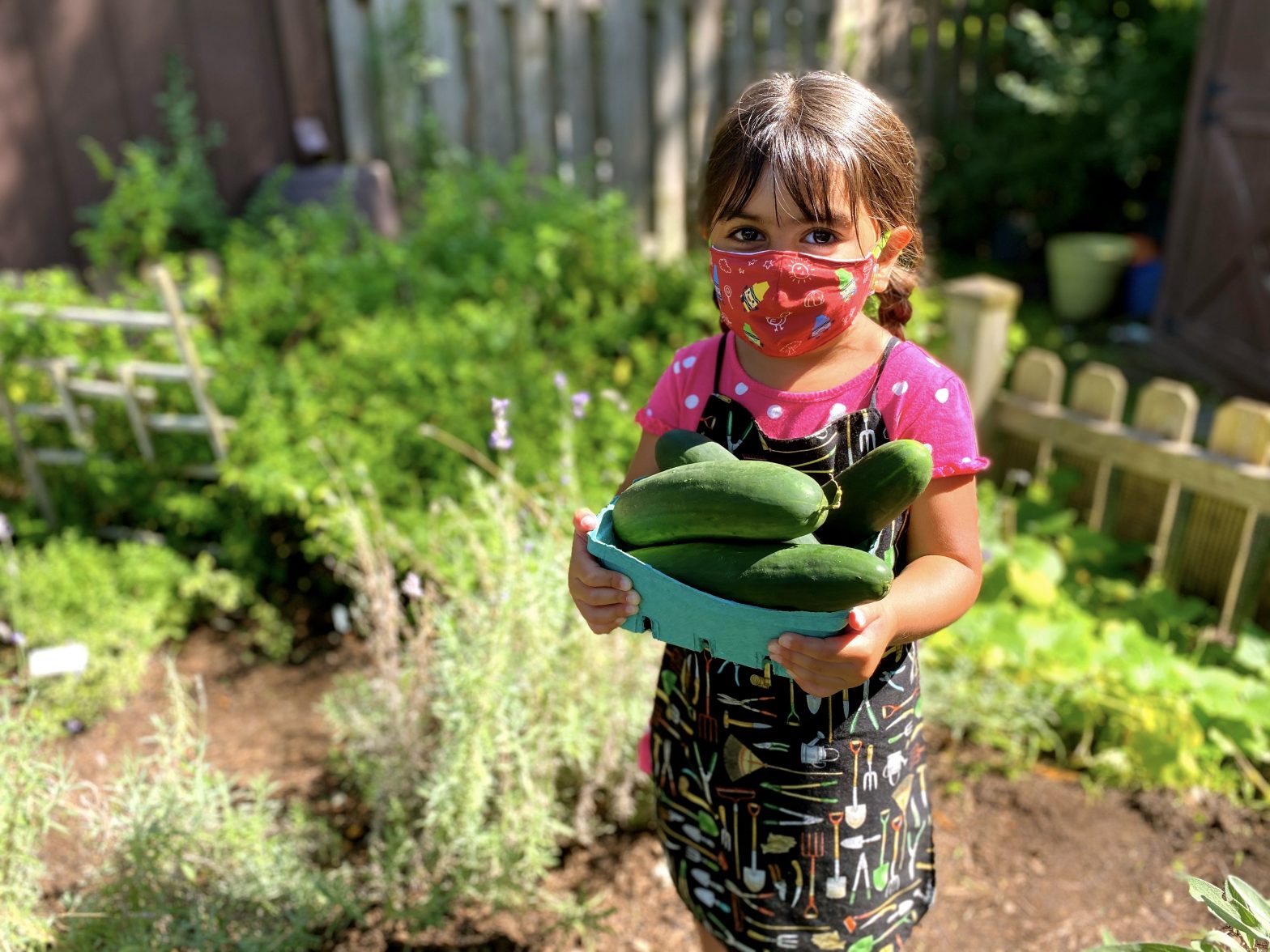Montessori articulates in The Montessori Method, “…man still belongs to nature, and especially when he is a child, he…draws from it the forces necessary to the development of the body and the spirit. We have intimate communications with nature which have an influence, even a material influence, on the growth of the body…”.
A window box, a barrel, or a small, raised garden will do just fine. You also need not have a green thumb yourself to begin to execute a garden with your child. Planting of any sort constructs a child’s sense of proficiency. Through his eyes, gardening is an “adult” activity. When allowed to sow a seed, water it, protect it and then observe it grow and produce—your child feels a sense of competence. It’s pretty magical, and that’s coming from someone who has a reasonably brown thumb. Though summer after summer I see the class light up as we bury our hands deep within the earth and enjoy every stage of the process together.
Outdoor “Practical Life” activities, such as gardening, provide advantages beyond those of practical life within our classrooms. Children develop a sense of pride and responsibility from the first stage of seed and plant selection onto planting and tending to the garden. So many virtues are learned, and lessons gained by simply planting a seed. Whether it’s on a grand or small scale, the process requires determination, patience, and commitment. Responsibility and accountability will also come into play when your child is given ownership of a flower or vegetable garden. He will quickly learn that consistent care is necessary for a plant to grow and flourish. The payoff is priceless when he is able to observe a lifecycle, from seed to flowering plant. Finally, a sense of accomplishment and pride is inevitable after harvesting a crop with one’s own hands.
Imagine your child involved in a simple gardening activity such as planting a seed. There are so many concepts to explore, discover, and learn. He will gain knowledge about science and nature when identifying plants. He will explore math skills by counting seeds in a packet. He will be exposed to reading and writing through stories, books, and activities such as composing a gardening journal. In our classrooms, he also gains social skills by working with other children and learning to collaboratively care for and nurture a living thing.
Even in the bitter cold and lifeless winter months, children can still connect with nature by gardening indoors. It gives children a connection with the outdoors, even though they are cooped up inside. Something all parents can identify with as their children wait anxiously for the warm spring air to return once again. One educational yet straightforward activity that you can do indoors is Bean Sprouting. Starting a bean seed to sprout roots is very gratifying for children. Teaching in a three to six-year-old class for the past thirty years, I have been fortunate to witness the intrigue and excitement that occurs when a child plants a simple bean. To get started, you will only need bean seeds, a clear jar or container, paper towels, and a small spray bottle or pitcher of water. Place seeds on paper towels in plastic cups or plastic bags (carefully place them so children can see them) and set them by a window. Moisten the beans with water; no soil needed. Mist daily with the water, but do not over mist, or you may get mold. Your child will marvel as the roots take off!
Additional indoor gardening projects include: Homegrown Citrus Trees, Growing a Sweet Potato Vine, and Popcorn Pies. Your child can plant his very own miniature citrus tree simply by drying a few lemons or orange seeds (pits). Let the seeds dry for a day or two before planting them in a small pot of soil. Place a few craft sticks around the edge of the pot and cover with plastic wrap. The baby citrus plant will need to be placed in a sunny and warm area. Your child should water the seedlings often, keeping the soil moist. Soon he will observe a stem poking through the mud. When leaves appear, remove the plastic and enjoy a new tree blossom with tiny white flowers and dark shiny leaves.
Sweet Potato Vines can be fun to grow at any age. With this easy activity, it is possible to have a string of leaves climbing throughout your kitchen. Place sweet potato in a large glass of water, half in and half out, and add water from time to time. Soon a vine will begin to cultivate and expand! Occasionally, the beautiful vine will produce lovely, lilac-colored sweet potato flowers. Finally, popcorn pie can be another fun and easy sprouting exercise for young children curious about gardening. Your child will most likely be surprised to learn that popcorn kernels are seeds too. Begin by filling a pie plate with potting soil and plant several kernels. Keep the soil moist and watch the sprouts emerge. Small, light green plants will make a beautiful popcorn pie plant.
These simple indoor gardening projects will make the transition to gardening outdoors a natural step for your child. He will have learned much more by seeing the growing process as it begins with the seed. The attention and care given to sprouting seeds and nurturing the young seedling are a significant part of the gardening experience. From the first stage of seed and plant selection on planting and tending to an outdoor garden, children develop a sense of pride, responsibility, and community.
A barrel, a window box, or a small, raised garden will do just fine. Whichever type of garden you choose, consider the climate and growing season before planting. Whether you use raised beds, containers, or ground plots, be sure to keep it small, very small. Put the plot in the best place possible with the best soil and plenty of light. Set your child up for success! Theme gardens can also be a lot of fun for young children. They help to personalize the gardening experience and tap into your child’s current interests. Some theme ideas are a Butterfly Garden, a Pizza Garden, a Rainbow of Color Garden, a Sunflower Garden, and a Snack Garden. Choose plants that will support the theme, such as cherry tomatoes or carrots, for a Snack Garden.
Some other things to consider while gardening at home or in a classroom setting:
- Plant a vegetable garden, and children can eat what they grow or Wildflowers to be cut for Flower Arranging. Perennials, along with Annuals, are lovely.
- Talk with children about patterns and cycles they observe, have them write about them.
- Find out the names of insects that appear in your garden. Which ones are beneficial — and which ones harmful to your plants?
- “Real” tools are a must! A metal, child-sized hoe, spade, and trowel. acknowledge the importance of the child’s work.
- Set up Independent Watering Activities.
- Consider companion activities:
-
-
- Watering
- Weeding
- Harvesting
-
- Build children’s vocabulary by describing what you see happening in the garden.
- Ask children to collaborate and draw or paint pictures of plants as they grow and write down what they observe.
- Read stories together to children about gardening.
Children are so proud of all of their accomplishments in the garden. Working in a garden, a child can encounter the satisfaction of caring for living things over time while observing the cycle of life. Caring for plants and sharing the harvest can be a fantastic confidence builder for young horticulturists. Offer your child this incredible opportunity by making your child’s first experience with gardening successful, but most importantly, make it fun!
-Michele Aspinall
Calls us to schedule your personalized virtual tour.
847-498-1105



Leave a Comment